|
Bottom of Shakespeare Cliff/Beach Street
Dover
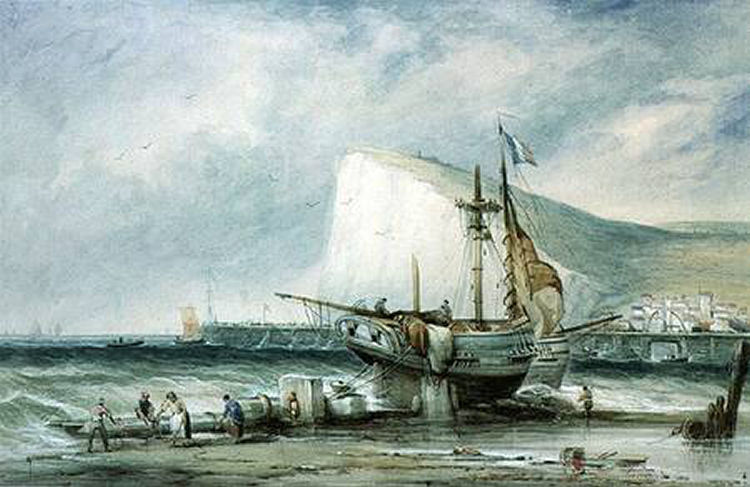
Samuel Austin (1796 - 1834)
"Shakespeare's Cliff, Dover, with Luggers on the Beach on" |
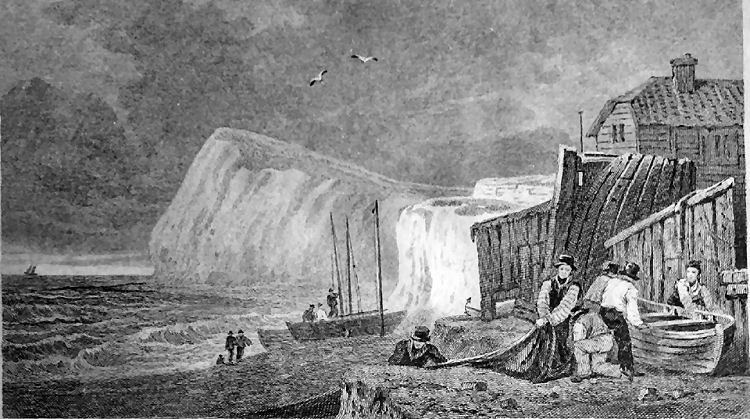
Above print showing fishing boats, and perhaps the "Mulberry Tree."
Engraved by Henry Adlard from an original study by Henry Gastineau 1831. |
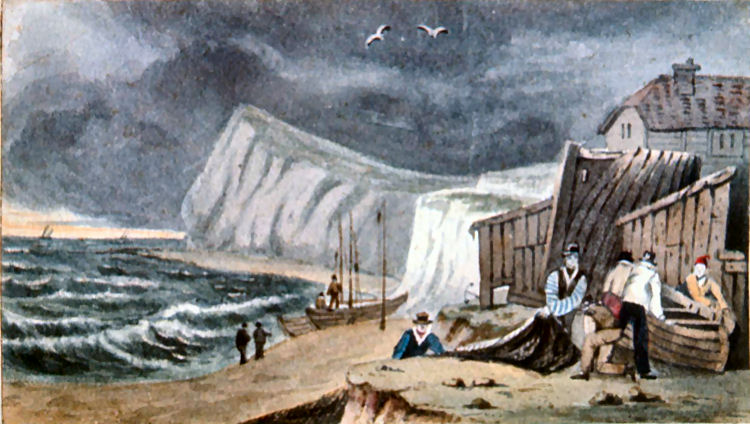
Above painting obviously taken from above print. The title says:-
"Shakespeare's Cliff. School copy from Print, J. W. H. 1832." |
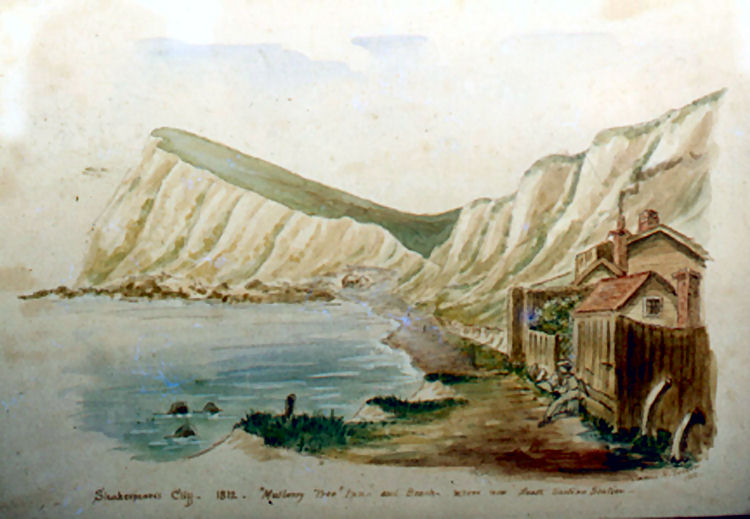
Above painting 1812, showing the "Mulberry Tree" and Shakespeare Cliff.
Title says:- "1812, Mulberry Tree Inn and beach where now stands ?????
Station." I can't make out the artists signature or date. |
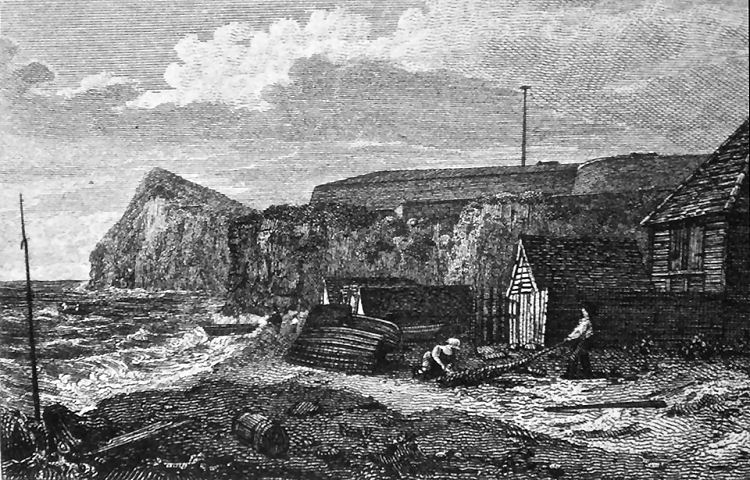
Above print by W. Doble, published 1877. Titled "Shakespeare's Cliff
& Archcliff Fort." |
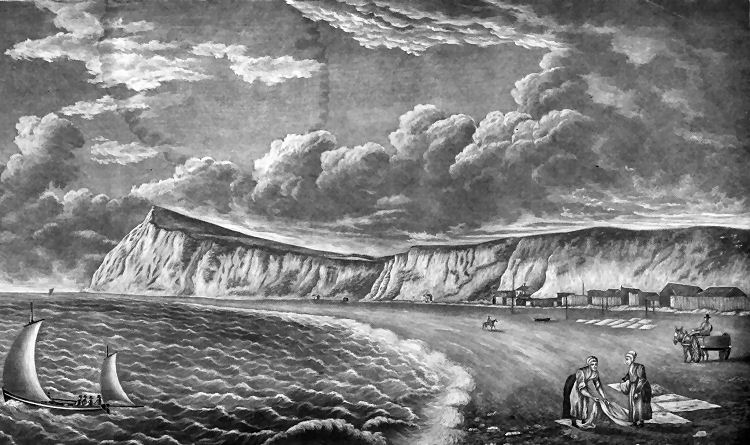
Above print showing the Shakespeare beach before the railway and
Becker's Steps. I believe the "Mulberry Tree" is just above the horse in
the print, date unknown. |
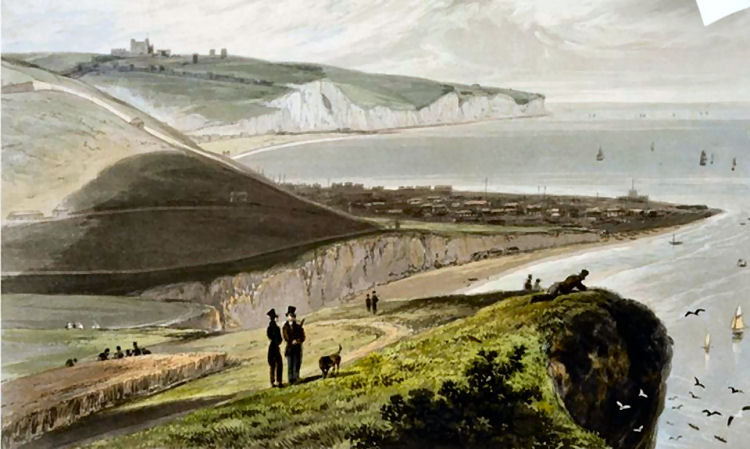
Above photo from Shakespeare Cliff, painted by William Daniell in 1829.
May just show the Mulberry Tree under the cliffs. |
|
Built at the extremity of the street under Arch Cliff, it was well
established in 1807 but its site had to be surrendered to the South
Eastern Railway when they arrived in 1843.
|
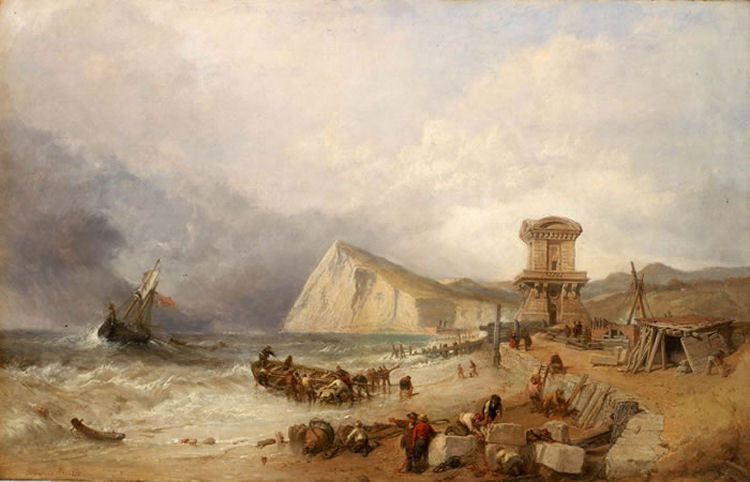
Shakespeare Cliff, Dover, 1849 Artist Clarkson Stanfield Date 1862
A composition in which the artist has incorporated recognisable
features at Dover, about 1849, with imaginary narrative. The painting
falls into two parts with a brig shown on the left amidst dark clouds
and a stormy sea. It is flying the red ensign upside down to indicate
that it is in distress. A boat is being launched from the beach to go to
its assistance. On the right preparatory stages for the construction of
a pier are underway. The artist has carefully delineated the various
processes involved at the building site such as a hoist, ladders and
blocks of stone together with several manual workers in red caps at the
site. They do not appear to be aware of the ship in trouble at sea and
this reinforces the appearance of two distinct narratives. Only the man,
woman and child in the middle distance look directly at the ship from
the raised quay.
The view is taken from the position of the modern Admiralty Pier, with
the sea on the left. Shakespeare's Cliff rises to dominate the skyline
in the distance with the two tunnels of the London-Dover railway visible
at its base, following the arrival of the South- Eastern Railway via
Folkestone in 1844. On the right is the Pilot's Watchtower, which was
constructed in 1847 and demolished by 1910. This structure was used to
house the pilots who were able to keep a continuous look-out for passing
vessels in need of their services to guide them safely into port. In
1846 there had been a recommendation that Dover become a harbour of
refuge 'capable of receiving any class of vessels under all
circumstances of the wind and tide'. The following year, probably the
year of the preliminary sketches for this painting, work began on the
western arm of the harbour commissioned by the Admiralty. The painting
can be seen as a glorification of industrial progress, and Dover as the
place at which England advances towards the continent of Europe, yet
equally defines its own boundary. The white cliffs bear a symbolic and
historical significance making Dover a locus of identity for the
sovereignty of the nation. However the inclusion of the contrived scene
on the left invites a less confident reading.
After Turner, Stanfield was considered the greatest British marine
painter of his day. He started his working life at sea, but his talent
for sketching attracted attention and from 1816 to 1834 he rose to
become the leading theatrical scene painter of his day. At the same time
his growing success as an easel painter of marine and coastal views
built him a success which enabled him to give up the stage and from 1835
he became an Academician of powerful influence. The painting is signed
'C Stanfield RA 1862' bottom left and was exhibited at the Royal Academy
in 1863.
|
|
From the Dover Telegraph and Cinque Ports General
Advertiser, Saturday 3 June, 1837. Price 7d.
SHOCKING OCCURRENCE
The inhabitants were thrown into a state of agitation an alarm on
Monday afternoon, by a fatal occurrence which has since proved a cause
of affliction and consternation to several respectable families in the
town. Soon after noon on that day, the body of a female was discovered,
quite dead, at he base of Shakespeare's Cliff; and from the dreadful
lacerations and disfigurement it presented, there could be no doubt of
the fact that the unfortunate lady had fallen from the 'dread summit of
chalky bourn,' the height of which above the spot where the body was
found, is at least three hundred and fifty feet. At about a hundred feet
from the base, a slipper was distinctly to be observed adhering to the
chalk, from which it may be inferred that her feet struck the face of
the cliff in the decent; but as no one saw her fall, the cause or manner
of her precipitation from the summit is unknown. The body being removed
to the "Mulberry Tree" public house, on the east side of the cliff, it
was discovered by her name written inside the remaining shoe, to be that
of Mrs. Catherine Elwin, wife of Mr. Elwin, grocer, in St. James's
Street, and was afterwards further identified by the dress she wore; but
from the disfigurement before remarked the features could not be
recognised by her relative who attended. Mrs. Elwin, it was stated, had
left home after breakfast, intending to take a walk previous to
proceeding to dine with her sister, Mrs. Birch, on the Military Road. A
lady was seen on the cliff about half past ten, by two of the coast
guard who were in a boat at sea; and she was also seen by persons from
the heights; but none of hem witnessed the fatal occurrence.
The place where the body was found being just without the limits of
Dover, the circumstances were reported to the County Coroner, and on
Wednesday an inquest was held at the "Mulberry Tree," before T. T.
Delasaux, Esq. and a jury from the parish of Hougham; Mr. R. Marsh, of
Farthingloe, foreman. The first witness examined was Richard Richards, a
fisherman. He stated that between twelve and one o'clock on Monday,
while walking on the low water rocks, he saw a lady's bonnet between him
and the cliff; and on going to pick it up, he discovered the body of the
deceased, in the situation above described. Life was entirely extinct. He body was not cold; but that might be accounted for by the heat of the
sun against the cliff. Witness called another man, named Mallett, from
the water rocks, who went for assistance; and others of the preventative
service coming up, they conveyed the body to the "Mulberry Tree."
Elizabeth Beer, servant to Mrs. Elwin, underwent a longer
examination. She saw the deceased at half past seven, on Monday morning,
when she took breakfast, in bed, as was her custom. She saw her mistress
again at half past eight, for the last time alive. There was nothing
different in her manner from her usual conduct; and witness understood
that she went out, intending to dine with her sister, Mrs. Birch, in the
Military Road - Believed there was a road from Shakespeare's cliff to
the Military Road. Her master, who dined at home, knew his wife was gone
out to dinner. About half past two he enquired what dress her mistress
wore when she went out? Witness could not tell; but ascertained from
what was taken from the room where she had dressed. She then heard of
the fatal event - thinks it was communicated to her master by Mrs.
Bradshaw. Mr. Elwin appeared agitated; and afterwards speaking of the
circumstance, he said it was a most extraordinary thing. Does not think
he left the house that evening, or that he had seen the body. He asked
if her mistress had said anything to her on going out? to which he
answered no. She did not see her go out. In answer to questions by the
Foreman and Jurors, witness said the deceased, who had six children,
attended correctly to the domestic and household affairs. She had been
unwell some time ago; but otherwise there was nothing particular in her
manner. she lived very comfortably with her husband. Witness did not
think that any couple could be happier than they were.
Mr. Thomas Birch, brother-in-law of the deceased, deposed that he had
known her from infancy. Her temper was extremely mild and placid; and
the fatal event was a blow which had stunned the whole family. She was
in the frequent habit of spending the day at his house; and the
impression on their minds was, that hse had taken a walk previous to her
intending going there on Monday; and his belief was, that she had met
her death accidentally. The effect of the fatal event was
extraordinarily severe on her husband, who seemed almost bereft of his
senses.
There being no other evidence, the coroner briefly remarked on that
adduced, observing that there was considerable mystery attached to the
melancholy circumstance; and nothing, perhaps, to warrant there giving
a verdict of accidental death. Still, on the other hand, they had
evidence that no derangement existed in the mind of the deceased. If
they felt justified in the performance of their duty to say accidental
death, it would become his duty to record it; but under all
circumstances, a general verdict of found dead, would be more advisable.
The jury then returned their verdict accordingly.
Found Dead.
|
|
From the Dover Telegraph, 14 July, 1838 p. 4 & 5
John HARVEY and wife
Elizabeth, of Dover: compensation case for their interest in a lease of
garden and premises known as the 'Mulberry Tree' public house at the
foot of Shakespeare's Cliff, held under the Lord of the Manor of
Sibertone for 21 years from Jan. 1835 at 20 shillings per year.
The site
now included in a schedule of lands in the Act of Parliament now
required by the Railway Co. for continuance of the line from the opening
of the tunnels to the town of Dover. Offer by the Company of £850 but
they demanded £2340. Three and half columns report of the case.
Witnesses re. Harvey's business and market garden. Jury decided on
£878.4s.
|
Although the above two pictures do not show the actually "Mulberry Tree",
I believe they show the relative location of it.
A "Mulberry Tree" was said to occupy ground at the entrance to
Shakespeare tunnel itself, complete with tea gardens, at the bottom of the zig-zag winding footpath which descended the
cliff. Apparently whilst the tunnellers were still engaged on that project.
Old prints do show a building in that vicinity. I know not if that is the
same. Many of those tunnellers were said to lodge in Archcliffe Square but I
have also read that not a room in the whole pier district was left unused.
I have also, just heard of another possible pub at a location down by the
sea, perhaps around the Lydden Spout area at the base of Shakespeare Cliffe.
See the "Shakespeare Head".
The Dover Express has a series "Way we were". In a recent edition, May
26th 2011, Terry Sutton has written about shipbuilder William King. The
feature includes mention of the "Mulberry Tree Inn." Extracts from that
write-up are as follows:-
[...] In the last ten years of the 18th century enterprising shipbuilder
William King was so popular he was eventually elected mayor of Dover. His
shipbuilding yard was on the harbour's southern beach, within near sight of
Townsend Battery and the pilot's lookout station near Cheeseman's Head.
[...] After their daily toil William King could often be found with his
workers sharing gossip with other shipwrights, hovellers and the occasional
smuggler at the "Mulberry Tree Inn," not far from Shakespeare Cliff. There
was much patriotic talk among the drinkers at the "Mulberry Tree" -- so much
that some of the more agile customers volunteered to join the ranks of the
Dover Volunteers, who were being armed to ward off a French invasion.
|
From "The Life and Times of Charles Norris Becker.
Charles Norris Becker was a town crier of Dover and he mentions the
following on a page of his book:-
PETER BECKER GRANDSIRE.
My grandfather, Peter Becker, was, in 1790, First Lieutenant in the
old Volunteers, under King George Ill. I have his indenture. Then he
kept a public house, "The Mulberry Tree" Inn, at the entrance of
Shakespeare's Cliff Tunnel, where a lot of smuggling was carried on. The
steps leading from the top of the Cliff were made by his instructions,
and were called "Peter Becker's Steps." Then he was proprietor of the
old Oil Mills as a corn store, which were burnt down but were not
insured. On November 8th, 1910, my sister Jane died; and on December
21st in the same year my adopted son, Arthur Minto, died at Lahour, East
India. My brother and his two lovely daughters are still at 154,
Snargate Street, in the greengrocery line; and your humble servant is
still in the land of the living at 130, Buckland Avenue, Dover.
Before closing my narrative, I should like to thank Sir William
Crundall and all the Town Councillors for the kindness I have received
during my term of office as Town Crier.
Dated this First Day of January, 1912.
CHARLES NORRIS BECKER.
|
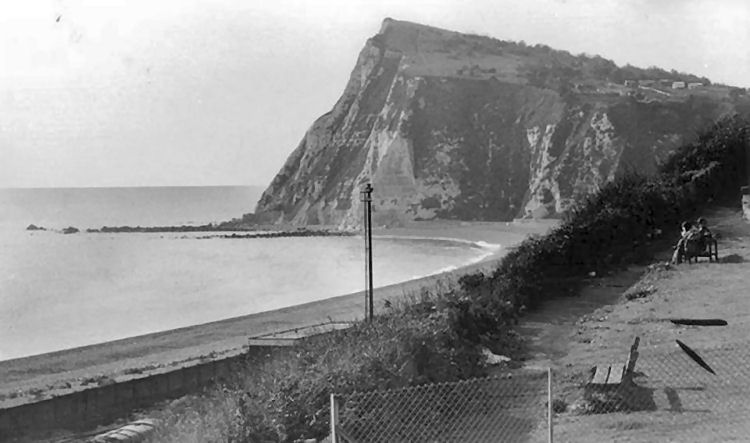
Above photo showing Shakespeare Cliff 1950, and I believe the rough area
that the "Mulberry Tree" would have been situated. |
LICENSEE LIST
BECKER Peter 1790+
HARVEY John 1838-43
GRAVENER Mr 1843
|








